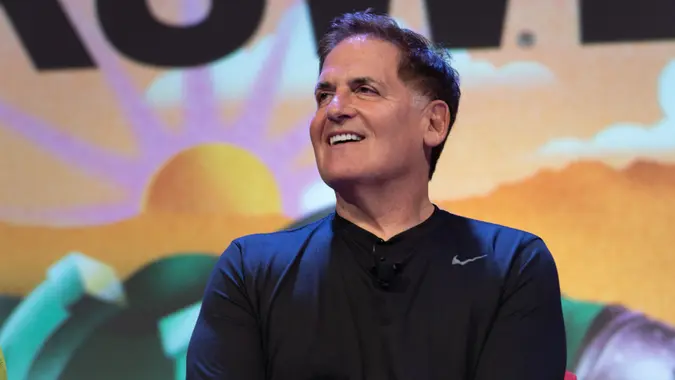5 Things Boomers Should Do With Their Money Now That Trump Will Be President

Commitment to Our Readers
GOBankingRates' editorial team is committed to bringing you unbiased reviews and information. We use data-driven methodologies to evaluate financial products and services - our reviews and ratings are not influenced by advertisers. You can read more about our editorial guidelines and our products and services review methodology.

20 Years
Helping You Live Richer

Reviewed
by Experts

Trusted by
Millions of Readers
In President-elect Donald Trump’s 20-point Agenda 47, his official platform of policies for his second stay in the White House, No. 14 promises to protect Social Security. But there are still many other agenda items that could benefit, or jeopardize, the plans of those close to or in retirement.
Here are some moves baby boomers might want to make before Trump takes office again.
Also, see three changes that could be coming to the economy in the next four years.
Stick With Certain Types of Stocks
Stocks are not inherently partisan, of course, but certain stocks and sectors typically benefit more from Republican policies, according to Paul Carlson, managing partner at Law Firm Velocity. So with Trump retaking the White House, backed by an all-Republican Congress, there’s a potential for shifting fiscal policy that could affect the stock market.
“Given his history with deregulation and tax cuts, it will probably impact sectors like energy and healthcare positively,” he said. “I’d lean into reallocating some of your portfolio into sectors that typically thrive under Republican leadership, like energy, financials and infrastructure.”
Diversify
Typically, those who reach retirement age are well diversified to hedge against risk. But boomers close to or in retirement might want to take an even safer stance with the change in the White House.
“Your portfolio of stocks and bonds may not be enough,” said Stuart Schiffman, founder and managing partner of Compound Wealth Advisors. “Consider adding positions in alternative assets like real estate, commodities and cryptocurrency, but don’t overdo it. Keep alternatives to no more than 10% of your portfolio.”
Carlson added that if your portfolio is heavy in tech stocks, now would be a good time to take some profits and diversify into more stable sectors.
Watch Inflation
Inflation was a major theme for both candidates during the presidential race. And despite the fact that inflation is now well under 3%, that doesn’t mean it’s definitively in the rearview mirror. Many economists see Trump’s tariff policies, if enacted, as inflationary. That includes Carlson, who advised boomers to prepare for this possibility.
“To be safe, you’ll want to budget for higher living costs and think about locking in fixed expenses where you can, like refinancing your mortgage or securing long-term care insurance now before rates climb,” Carslon said.
As far as investments, he suggested considering inflation-protected securities like TIPS (Treasury Inflation-Protected Securities). “They’re designed to guard against inflation and can provide a reliable income stream while preserving your purchasing power over time,” he said. “And don’t forget about the grocery bills either. I’d recommend stocking up on essentials when prices are low, which saves you a bundle later.”
Schiffman also advised remaining an inflation hawk for the foreseeable future by insulating your portfolio from potential rising bond yields and rising prices. “For your stock portfolio, consider increasing defensive positions. Blue chip dividend-paying stocks will decrease the volatility of your portfolio,” he said. “Consider dividend growth exchange-traded funds like VIG and DGRO. For the bond portfolio, stay in short-duration maturities.”
Have Reserves
Now more than ever, when change is the only constant and uncertainty — the market’s least favorite word — is everywhere, creating a liquid reserve fund for emergencies is essential, Schiffman said.
“You should have somewhere between three to six months of cash or near cash reserves for emergencies. You absolutely want to avoid selling assets in down markets, otherwise you face what is known as sequence of returns risk,” he explained.
Create Bucket Lists
Regardless of who’s in the White House or which party controls Congress, Carlson advocated creating a “retirement bucket list” that includes experiences rather than material possessions. “You can work towards every goal on that list with the help of a flexible retirement plan,” he said. “It basically includes having a mix of savings and investments that can adapt to changing circumstances.”
Schiffman also suggested creating a bucket list of sorts, this one to organize your finances. “Use a three bucket strategy to divide your assets between short-, intermediate- and long-term needs,” he said. “This will help you stay the course. Refill buckets as needed from longer dated assets.”
Editor’s note on political coverage: GOBankingRates is nonpartisan and strives to cover all aspects of the economy objectively and present balanced reports on politically focused finance stories. You can find more coverage of this topic on GOBankingRates.com.
More From GOBankingRates
 Written by
Written by  Edited by
Edited by 

























